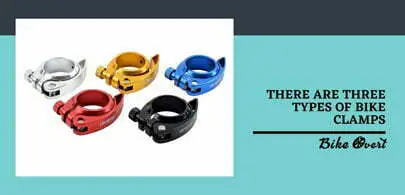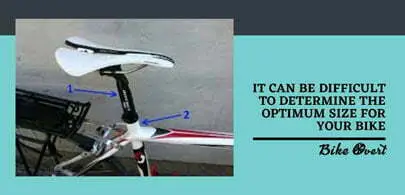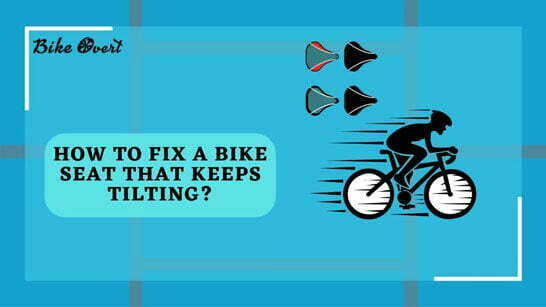What are the best bike seat clamp sizes? How to use a vernier caliper to measure bike seat clamp? How to fix a bike seat from tilting?
Bike seat clamps are the adjustable device that is installed on most mountain bikes between the saddle and handlebars. The clamp is tightened to lock the seat in place. Measuring your seat size will allow you to find the best clamp size for your bike. The bike seat clamp size is the measurement from the bicycle tube to the clamp.
The best way to measure it is to use a steel ruler and take a straight line measuring from the center of the bicycle’s tube, vertically up towards the inside of the bike frame. Then take another line horizontally across. This should give you an accurate measurement of your bike frame’s diameter, which will be used to find out what you need for your frame size.
Bike seat clamp types

Bike seats are used to make riding more comfortable by providing the rider with a place to set their sit bones. The important part of the seat is known as “seat clamp” which is made up of two pieces that are screwed together in order for it to be attached to the bike frame. There are different companies that make bike seat clamps, but one of the most widely used is the Velo Orange 270.
The clamp can be made of metal, plastic, rubber, or nylon which the seat rests up against. There are three types of clamps – bolt-on, U-shaped swing arm, and quick release.
- The bolt-on bike seat clamp – is the easiest to install and use. It consists of two bolts that attach securely to the bike’s rails. It has a hexagonal head on each end of the clamp so they fit into matching holes on either side of the bicycle’s top tube. The bolts go through these holes and then thread down inside the top tube where they attach to the bottom bracket shell.
- U-shaped swing arm bike seat clamp- This type of clamp attaches to the frame by means of an adjustable bar with one end attached to the saddle post and another end connected to the frame rail. A spring-loaded lever holds it in place while you tighten the nuts at both ends. Once tightened, this clamp will not move unless someone pulls hard enough on the handlebars or pedals.
- Quick release- These clamps are used for quick removal from a fixed position when changing bikes. They have two parts: 1) a bolt that goes through the frame rails and 2) a nut that is threaded onto the other part which fits over the head of the bolt.
Best bike seat clamp sizes

Many bike seats require a specific size of bike clamp to be tightened before it can be securely mounted. With so many different sizes, it can be difficult to determine the optimum size for your bike.
The best way to avoid confusion is to consult your local bike shop or review the website for the manufacturer of your bike seat. Once you know what size you need, purchasing a new one will take care of any problems that you may have had with a loose or wobbly seat.
Ideal seat clamp sizes
Seat clamp sizes are related to the seat tube. The larger the diameter of the seat tube, the smaller the seat clamp’s measurement. For example, if you measure the inside circumference of an 18-inch bicycle frame and find that it measures 1 inch, then you’ll know that the seat tube has a diameter of about 2 inches.
The five common seat tube diameters are 28.6mm, 30.0mm, 31.8mm, 34.9mm, and 36.4mm. Once you know the size of your seat tube with a caliper or check your seat tube’s manufacturer, make sure to buy a seat clamp that matches.
If you’re in the process of shopping for a new bike seat clamp or you’re just trying to figure out what size seat clamp you need, it can be helpful to know how seat clamps are measured. Seat clamps are typically measured by millimeters. If you want information on the best seat clamp sizes, read on.
How to measure a bike seat clamp?
Measure a bike seat clamp by first placing the widest part of the calipers on the top of the handlebar. Then place it at the hole where you want to measure. Then take a reading from one side to the other, and voila!
There are 3 ways to measure your existing seat clamp:
1. Inside measurement
Measure the distance between the holes on both sides of the bar. This is called the “inside measurement.” The inside measurement should equal about half the width of the seat post plus 2 inches. For example, if your seatpost has an outside diameter of 1 inch, then the inside measurement would be approximately 0.5 + 2 = 3 inches.
2. Outside measurement
Measure the distance across the entire length of the clamp. This is called the “outside measurement” or just simply the “length”. You can use this method if you have an old-school style clamp that has no holes in them. If it does not have any holes, measure from one end to the other and add a few extra inches for good measure. In our case, we are measuring 12 inches so we will need 13+ inches.
3. Seat clamp height measurement
The seat clamp height measurement is an important aspect of the bicycle geometry. The seat clamp is the point where the seat post inserts into the frame of the bicycle, or vice versa. A lot of bikers measure seat height by the distance from the top of the seat to the ground.
However, this measurement can be inaccurate as it is more complicated than that. This is because many people’s leg lengths are different. To measure a bike seat clamp height accurately, it should be measured from the top of your seat to the center point on your crank arm, which is where you would place your foot if you were riding a bike.
How to use a vernier caliper to measure bike seat clamp?

A Vernier caliper is a device used to measure the distance between two points. The measurement of a bike seat clamp is often done with a Vernier caliper to see how it can be tightened to make the rider feel more comfortable. A common misconception about the use of a Vernier caliper is that it doesn’t have measuring capabilities, but in actuality, it has both an inside and outside measurement capability.
The task at hand is not as easy as it may seem. You need to know which caliper to use, how many millimeters the bike seat clamp needs to measure to fit your bike, and how much torque you should be using. The first step is deciding if you need a digital caliper or an analog caliper. The answer usually depends on your preference or what your job entails.
Measure the Seat Tube with the Vernier Caliper
For measuring a seat tube with a vernier caliper , follow these steps:
- Place one end of the caliper over the top edge of the seat post
- Measure from the centerline of the bottom bracket shell to where the caliper meets the frame
- Repeat this process for the other side of the seatpost.
This will give you two measurements that are equal in length. If they aren’t exactly the same, then it means there was some error somewhere along the way.
Measure seat clamp with a vernier caliper
For measuring seat clamp with vernier caliper , follow these steps:
- Hold the caliper so that its jaws face down and measure across the width of the seat clamp at the widest point on each jaw
- Add up both numbers to get your total measurement. This is how much space you have between the clamps when closed. You can use a ruler or tape measure if needed.
How to fix a bike seat from tilting
There are some easy and quick fixes to tighten a new bike seat that has begun to tilt. One of the most common causes of the seat tilting is due to loose bolts on the frame or on the clamping screws. Loose bolts will need to be tightened with a wrench, while clamping screws can be tightened by hand. If tightening these bolts does not work, there may be some damage to the frame rails.
You can read this article for more information about fixing a tilted bicycle seat. There you’ll find how to loosen the bolt holding the saddle in place, as well as other tips and tricks. You will be able to fix your own problem quickly and easily!
How to make bike seats more comfortable?
Bike seats are notorious for not being comfortable. Here’s some advice on how to make your bike seat more comfortable:
- Make sure your bike seat is the correct height for your body. Stand over it and if it feels like you’re standing up on tippy toes, then it might be too high. If you feel like you’re stretching to reach the pedals, then it might be too low.
- Adjust the angle of your seat so that it fits comfortably under your hips. This can usually be done by loosening one or two bolts at either end of the seat post. The best way to do this is with an adjustable wrench. It should take only seconds to adjust the seat properly.
There are plenty of ways to make bicycle seats more comfortable for riders. You can read this article where we talk about different types of saddles that have been designed specifically with comfort in mind.
Conclusion
People should measure their bike before making a decision on the size of the clamps. The second most important thing to consider is your height. If you are tall, then you want to use a large one because it will allow the seat to be at the right height for you.




